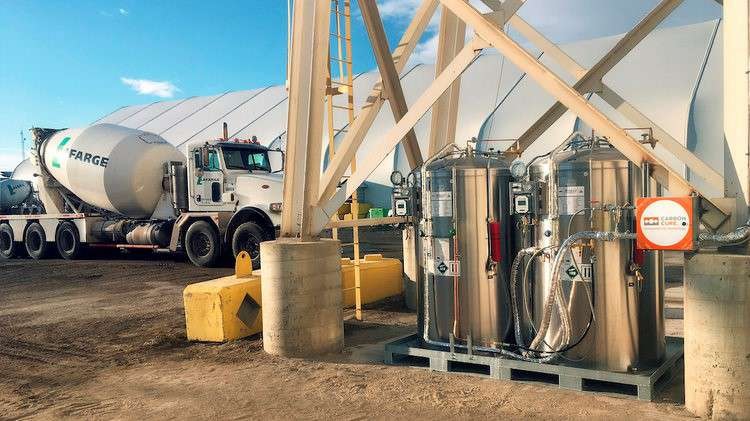Producing cement for concrete results in high levels of CO2 output and is the third ranking cause of man-made CO2 in the world after transport & energy generation. Low-Carbon Concrete is needed for Building Green Homes…
Low-carbon concrete – “green” cement at last?
One of the most essential and commonly-used building materials in home construction, commercial buildings and city infrastructure is concrete, which has an extremely high carbon footprint, with cement production accounting for 7% of global carbon emission. This problem is considered to be increasing at a time we are supposed to be reducing carbon output due to dramatic growth of populations and the need for more homes and city infrastructure predicted over the next 30 years.
Environmentalists have encouraged city planners, architects and construction professionals to find alternatives to concrete for years in the quest for a lower carbon footprint in the built environment in the quest for zero carbon homes – and now a Canadian company may have the answer with a carbon-sequestering concrete system that appears to have the attributes ideal for general use across all building sectors, and that is gaining fans in the green building community. Is CarbonCure low-carbon concrete the solution we’ve been waiting for to reduce the carbon output from home building?
Concrete in homes = high carbon footprint
Have you seen a house without any concrete in it? it’s not impossible to build a home without concrete as you could rest a home on screw piles, but you really don’t see that very often. Almost every home in North America is either seated on a concrete foundation and basement, or a concrete slab on grade foundation. A very
large percentage of the total lifecycle carbon emissions of a home is due to the foundation, so cleaning that up would greatly reduce the total greenhouse gas emissions (GHGs) of a home.
Carbon sequestering is one of the more hopeful solutions to slowing runaway climate change, as it prevents the release of carbon into the atmosphere. Currently the only real carbon storage option in green building materials comes from natural building products such as strawbales, wood for framing, cellulose insulation, hemp insulation, insulated wood fiberboard panels, MDF panels made from rice, and other wood products such as formaldehyde-free OSB or plywood.
There is a growing trend in the green home building industry to use more eco-friendly building materials, and due to that demand, more manufacturers are showing up in the market all the time as demand increases. But nothing so far can touch the impact that carbon storage in concrete could have if this became the norm around the globe.
Where does the carbon in concrete come from?
Concrete is made with a mix of crushed stone, sand, water, and Portland cement. The heavy carbon contributor in that mix is the cement. It requires a significant amount of energy to produce, and for every ton produced, one ton of carbon is released into the atmosphere contributing to climate change if the science has it right. Low Carbon Concrete by CarbonCure is produced by regular ready mix concrete plants as an admix.
The most interesting part about this new low-carbon concrete is that the process can be added to just about any concrete plant – and although there’s an investment in new equipment to make it happen, the existing equipment doesn’t have to be junked. In effect it’s a “fancy new” carbon admix in the form of a mineral which is injected into the mix.
The benefits of carbon storage in concrete are twofold – on one hand CO2 is being introduced to the mix, so once the concrete hardens it is sequestered forever, and
the other benefit is that adding carbon to concrete actually makes it stronger. That means between 5% and 7% less cement is needed to achieve the same compression strength. Using less of the most expensive ingredient offsets the added cost of carbon, so the price for this “eco-friendly” concrete remains about the same.
According to Christie Gamble, the Director of Sustainability at CarbonCure, the Canadian company behind this innovation, this technique does not require any change in the production procedure, and allows ready-mix firms to use less Portland cement.
“Operationally, it is very simple,” she said. “It’s essentially the same as injecting an admixture into the mix except in this case the admixture is C02 that originally came from an emitter source.”
How much carbon footprint can low-carbon concrete solve?
There is a 12 story development in Atlanta, Georgia that is the largest project ever to use carbon cure concrete, and that project alone is estimated to have sequestered 1.5 million lbs of CO2 in 4,800 cubic yards of concrete, which is the equivalent to what 800 acres of forest can sequester in a year, or to use the medias favorite comparison – taking 1.5 million cars off the road.
Low-Carbon Ready Mix Concrete helps Reduce the Carbon Footprint of Green Buildings
According to an article in Scientific America, The U.S. used over 122 million metric tons of Portland cement in 2006, and during that same time period China used at least 800 million metric tons. With the amount of carbon cure concrete produced by just 23 plants, 10 million lbs of CO2 emissions were sequestered rather than being released into the atmosphere – so that’s certainly a start on the right path.
Ecohome March 4, 2020Last updated: July 28, 2021, Mike Reynolds
https://www.ecohome.net/guides/3517/low-carbon-concrete-lowers-carbon-footprint-co2-sequestering-carbonccure/


